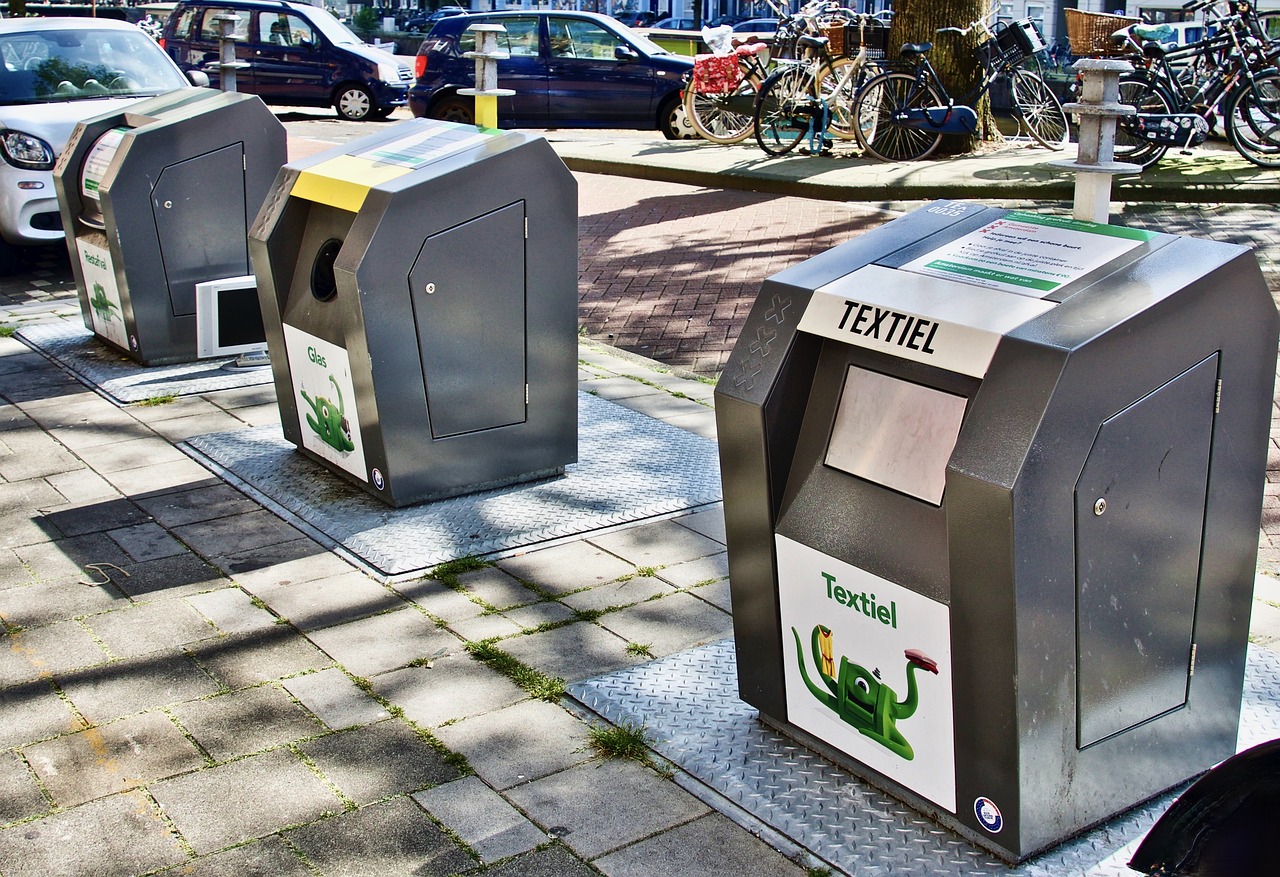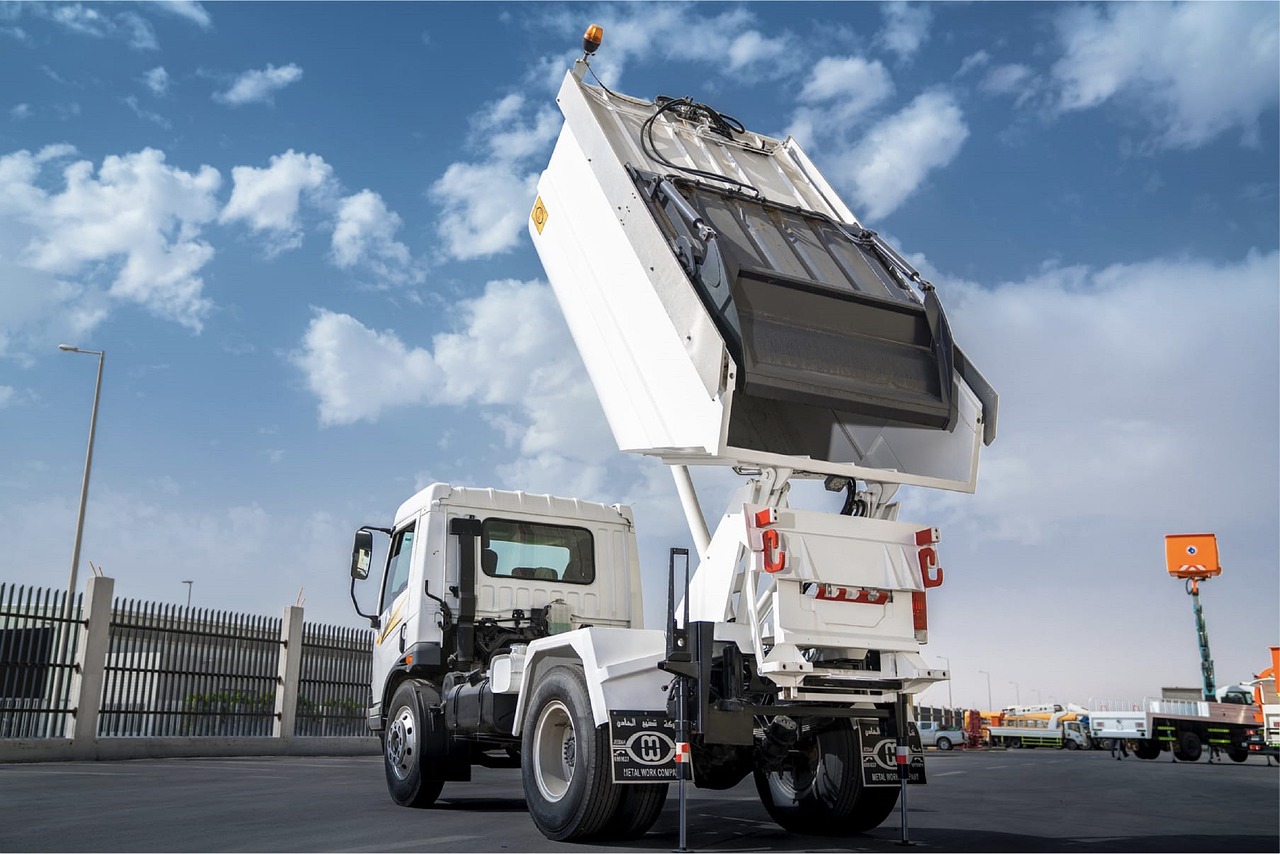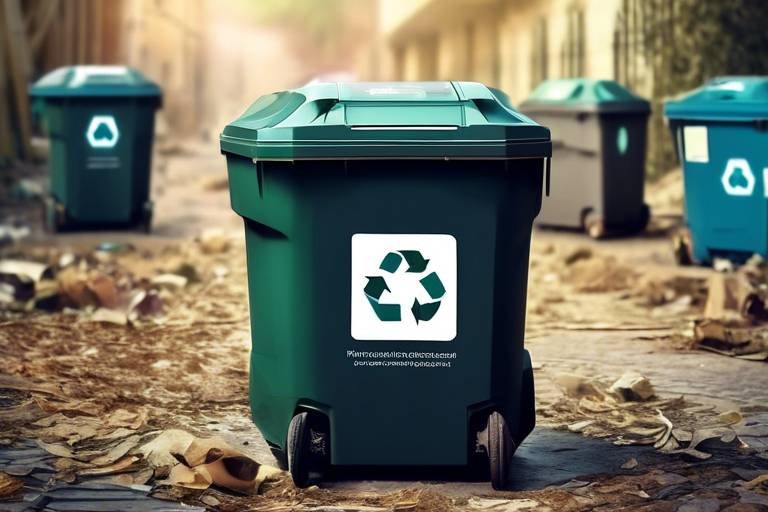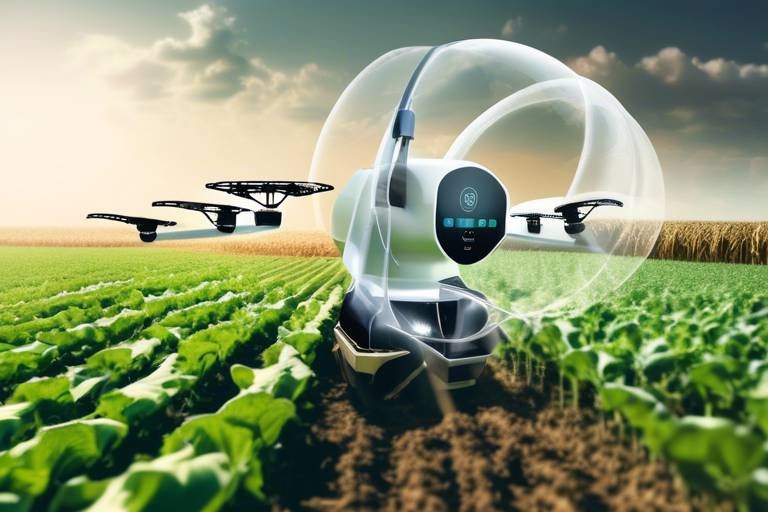The Future of Smart Waste Management Systems
As urban populations continue to grow and environmental concerns escalate, the need for effective waste management becomes increasingly critical. The future of smart waste management systems is not just about keeping our streets clean; it's about embracing innovative technologies that can transform how we handle waste. Imagine a world where garbage collection is optimized, recycling rates soar, and landfills shrink—all thanks to smart systems that leverage cutting-edge technology.
At the heart of this transformation are advancements in technology that are revolutionizing waste management. Smart sensors, artificial intelligence (AI), and the Internet of Things (IoT) are paving the way for more efficient collection processes and enhanced recycling initiatives. These technologies are not just buzzwords; they represent a shift toward sustainability that can significantly reduce our environmental footprint.
Consider this: smart bins equipped with sensors can detect when they are full and send alerts for collection. This means no more unnecessary trips by waste collection vehicles, which not only saves time and resources but also reduces emissions. The integration of AI allows for predictive analytics that can forecast waste generation patterns, enabling cities to allocate resources more effectively and plan collections based on actual needs rather than estimates.
But what does this mean for the average citizen? It means cleaner streets, less waste in landfills, and a more sustainable future. As smart waste management systems evolve, communities will have the opportunity to engage more actively in sustainability initiatives. Imagine being part of a city where your waste disposal habits contribute to a larger goal of environmental stewardship. The future is not just in the hands of city planners; it’s a collective effort that requires participation from everyone.
In summary, the future of smart waste management systems is bright and full of potential. By harnessing technology, we can create urban environments that are not only cleaner but also more sustainable. As we look ahead, it's essential to keep the conversation going about how we can all contribute to this evolving landscape. Are you ready to be part of the change?
- What are smart waste management systems? Smart waste management systems utilize technology like sensors and AI to optimize waste collection and recycling processes.
- How do smart bins work? Smart bins are equipped with sensors that monitor fill levels and send alerts for collection, reducing unnecessary trips and improving efficiency.
- What are the benefits of using smart waste management systems? Benefits include improved operational efficiency, reduced costs, enhanced recycling rates, and a smaller environmental footprint.
- What challenges do cities face in implementing these systems? Challenges include high initial costs, maintenance issues, and the need for robust data management systems.
- How can communities engage in waste management initiatives? Communities can participate through education programs, responsible waste disposal practices, and involvement in local sustainability efforts.

Emerging Technologies in Waste Management
As we navigate through the complexities of modern urban living, the need for efficient waste management has never been more pressing. Emerging technologies are stepping up to the plate, revolutionizing the way we handle waste. Imagine a world where waste collection is not just a routine chore but a finely tuned operation powered by smart sensors, artificial intelligence (AI), and the Internet of Things (IoT). These innovations are not just buzzwords; they are the backbone of a new era in waste management that emphasizes efficiency and sustainability.
At the forefront of this transformation are smart sensors embedded in waste bins. These sensors monitor fill levels in real-time, providing crucial data that informs collection schedules. Instead of drivers making unnecessary trips to empty bins that are only partially full, the system sends alerts when bins reach a predefined capacity. This not only saves time but also reduces fuel consumption and greenhouse gas emissions. Think of it as a smart waste management orchestra, where each component plays its part to create a harmonious and efficient operation.
Furthermore, AI algorithms analyze the data collected from these sensors to optimize routes for waste collection vehicles. By leveraging historical data and predictive analytics, cities can anticipate peak waste periods and adjust their schedules accordingly. This is akin to a chess game, where every move is calculated to ensure maximum efficiency. The result? Less traffic congestion, reduced operational costs, and a cleaner urban environment.
But it doesn't stop there. The integration of IoT solutions allows for seamless communication between various waste management components. For instance, smart bins can connect to a central system, providing a holistic view of waste management across the city. This interconnectedness enables waste management authorities to make data-driven decisions that enhance recycling efforts and reduce landfill contributions. In essence, it transforms waste management from a reactive process into a proactive strategy.
Moreover, the role of data analytics cannot be understated. By analyzing waste composition and generation patterns, cities can identify opportunities for improvement. For example, if a particular neighborhood consistently produces more organic waste, targeted composting initiatives can be introduced. This tailored approach ensures that each community's unique waste challenges are addressed effectively, leading to a more sustainable future.
In conclusion, the emergence of these technologies is not just a trend; it represents a fundamental shift in how we approach waste management. As cities continue to grow, embracing these innovations will be crucial in creating sustainable urban environments. The future is bright, and with smart waste management systems, we are on the path to a cleaner, greener world.

The Role of IoT in Waste Management
The Internet of Things (IoT) is revolutionizing waste management by providing innovative solutions that enhance the efficiency and effectiveness of waste collection and disposal processes. Imagine a world where garbage trucks know exactly when a bin is full and need to be emptied, instead of following a predetermined route. This is not just a dream; it’s becoming a reality thanks to IoT technology. By integrating sensors and smart devices, cities can optimize their waste management systems, leading to significant cost savings and improved service delivery.
At the core of IoT in waste management are smart sensors installed in waste bins. These sensors monitor the fill levels of bins in real-time. When a bin reaches a certain capacity, it sends an alert to the waste management system, prompting timely collection. This not only reduces the number of unnecessary trips made by collection vehicles but also minimizes fuel consumption and emissions, making the entire process more environmentally friendly. Think of it as a smart assistant for waste management—always alert and ready to optimize operations!
Moreover, the data collected from these smart bins can be analyzed to identify patterns in waste generation. For instance, certain neighborhoods may produce more waste on weekends or during holidays. By understanding these trends, waste management authorities can adjust their collection schedules accordingly, ensuring that resources are allocated where they are needed most. This proactive approach not only enhances efficiency but also improves customer satisfaction, as residents benefit from timely waste collection services.
Smart bins equipped with advanced sensors are the backbone of IoT applications in waste management. These bins can detect not only fill levels but also the type of waste being disposed of. For example, if a smart bin is designed to separate recyclables from general waste, it can alert the collection team if the bin is contaminated with non-recyclable materials. This feature is crucial for maintaining recycling standards and ensuring that materials are processed correctly.
Utilizing smart bins brings numerous benefits that extend beyond mere convenience. Some of the key advantages include:
- Operational Efficiency: By collecting data on bin fill levels, cities can streamline their collection routes, reducing fuel consumption and labor costs.
- Enhanced Recycling Rates: With real-time data, waste management authorities can implement targeted recycling initiatives, increasing community participation in recycling efforts.
- Cost Savings: Fewer collection trips mean lower operational costs, allowing cities to allocate funds to other critical areas.
Despite the clear advantages, implementing IoT solutions in waste management is not without challenges. The initial costs of installing smart bins and sensors can be high, which may deter some municipalities from making the investment. Additionally, maintaining these systems requires a robust infrastructure for data management, which can also be costly. Furthermore, the integration of IoT technology into existing waste management systems may face resistance from stakeholders who are accustomed to traditional methods.
Nevertheless, as technology continues to advance and the demand for sustainable practices grows, the benefits of IoT in waste management will likely outweigh the challenges. Cities that embrace these innovative solutions will not only improve their waste management processes but also contribute to a cleaner and more sustainable environment.
Q: What is IoT in waste management?
A: IoT in waste management refers to the integration of smart sensors and devices that monitor and optimize waste collection and disposal processes in real-time.
Q: How do smart bins work?
A: Smart bins are equipped with sensors that detect fill levels and send alerts when they need to be emptied, allowing for optimized collection routes and schedules.
Q: What are the benefits of using IoT in waste management?
A: The benefits include improved operational efficiency, enhanced recycling rates, cost savings, and a reduced environmental footprint.
Q: What challenges do cities face when implementing IoT solutions?
A: Challenges include high initial costs, maintenance issues, and the need for robust data management systems.

Smart Bins and Sensors
Imagine a world where waste management is as effortless as checking your smartphone for messages. Smart bins equipped with cutting-edge sensors are making this dream a reality. These advanced waste receptacles can detect how full they are and send real-time alerts to waste management teams when they need to be emptied. This technology not only enhances the efficiency of waste collection but also significantly reduces the number of unnecessary trips made by collection vehicles. Picture this: a garbage truck driving around town, only to find that several bins are barely half full. What a waste of time and fuel! Smart bins eliminate this issue, ensuring that resources are used wisely.
These intelligent containers are typically outfitted with a variety of sensors, including ultrasonic sensors, which measure the fill level of the bin, and weight sensors, which can determine how much waste is inside. By gathering this data, cities can optimize their waste collection routes and schedules, leading to not only cost savings but also a reduced environmental impact. For instance, a city that implements smart bins could see a decrease in fuel consumption and emissions, contributing to a cleaner, greener urban environment.
But the benefits of smart bins extend beyond just operational efficiency. They also play a crucial role in promoting recycling. By tracking the types and amounts of waste being disposed of, municipalities can gain valuable insights into waste patterns. This data can inform educational campaigns aimed at encouraging residents to recycle more effectively. For example, if a neighborhood is generating a lot of recyclable materials, targeted initiatives can be launched to further boost recycling rates.
However, the implementation of smart bins is not without its challenges. The initial costs of purchasing and installing these high-tech containers can be significant. Additionally, maintaining the technology and ensuring that the data collected is accurately managed requires a robust infrastructure. Cities must invest in not only the bins themselves but also in the systems that will analyze the data and integrate it into existing waste management practices.
In summary, smart bins and sensors represent a significant leap forward in the realm of waste management. They offer a multitude of benefits, including:
- Enhanced Efficiency: Reducing unnecessary collection trips saves time and resources.
- Improved Recycling Rates: Data collection can lead to better recycling initiatives.
- Environmental Impact: Less fuel consumption translates to lower emissions.
As cities continue to embrace these innovations, the potential for a cleaner, more sustainable future becomes increasingly attainable. The journey towards smarter waste management is just beginning, and smart bins are at the forefront of this exciting evolution.

Benefits of Smart Bins
Smart bins represent a groundbreaking shift in the way we manage waste, offering a plethora of benefits that extend far beyond mere convenience. Imagine a world where waste collection is not just a routine chore but a finely tuned operation that maximizes efficiency and minimizes environmental impact. Smart bins, equipped with advanced sensors and connectivity features, are at the forefront of this transformation. One of the most significant advantages of these intelligent waste containers is their ability to detect fill levels in real-time. This means that they can send alerts to waste management teams when they are nearing capacity, ensuring that collections occur only when necessary. As a result, unnecessary trips to empty bins are significantly reduced, leading to lower operational costs and a smaller carbon footprint.
Moreover, smart bins contribute to enhanced recycling rates. By monitoring the types of waste being disposed of, these bins can provide valuable data that helps municipalities to tailor their recycling programs more effectively. For instance, if a smart bin consistently collects a high volume of recyclable materials, it can trigger initiatives to increase public awareness about recycling in that area. This proactive approach not only boosts recycling rates but also fosters a sense of community responsibility towards waste management.
Another compelling benefit is the improved data collection capabilities that smart bins offer. With their ability to gather and transmit data, cities can analyze waste patterns and make informed decisions about resource allocation. For example, if certain areas generate more waste during specific times of the year, cities can adjust collection schedules accordingly. This data-driven approach ensures that resources are utilized efficiently, ultimately leading to a more sustainable waste management system.
In summary, the benefits of smart bins are manifold. They lead to:
- Cost Savings: Reduced operational costs through optimized collection routes.
- Increased Recycling: Enhanced recycling rates through better data and community engagement.
- Data-Driven Decisions: Improved resource allocation based on real-time waste patterns.
As we continue to embrace smart technology in our urban environments, it's clear that smart bins are not just a passing trend; they are a vital component of a sustainable future. With their ability to streamline operations and promote responsible waste disposal, smart bins are paving the way for a cleaner, greener world.
- What are smart bins?
Smart bins are waste containers equipped with sensors that monitor fill levels and other data to optimize waste collection. - How do smart bins improve recycling rates?
They provide valuable data about waste composition, allowing municipalities to tailor recycling programs and increase public awareness. - Are smart bins cost-effective?
Yes, they reduce operational costs by minimizing unnecessary collection trips and optimizing routes based on real-time data. - What challenges are associated with implementing smart bins?
Challenges include high initial costs, maintenance issues, and the need for robust data management systems.

Challenges of Implementation
Implementing smart waste management systems, while promising great benefits, is not without its challenges. One of the most significant hurdles is the high initial cost associated with the deployment of advanced technologies. These systems often require substantial investment in hardware, such as smart bins and sensors, as well as software for data management and analytics. For many municipalities, especially those with tight budgets, this can be a daunting barrier to entry.
Additionally, the maintenance of these smart systems presents another challenge. Regular upkeep is essential to ensure that sensors and other technology continue to function correctly. This maintenance often requires specialized skills and training, which can lead to further costs and complications. Imagine investing in a shiny new gadget only to find out that keeping it in top shape is more trouble than it’s worth. Without proper maintenance, the benefits of smart waste management can quickly diminish.
Moreover, cities must grapple with the need for robust data management systems. The data collected from smart bins and sensors is only as good as the systems in place to analyze and act upon it. Many municipalities may lack the infrastructure or expertise to effectively process this data, leading to missed opportunities for optimization. It’s like having a treasure map but not knowing how to read it; the potential is there, but without the right tools, it remains untapped.
Lastly, there is the challenge of public acceptance and understanding. For smart waste management systems to be successful, the community must be on board. This requires effective communication and education about how these systems work and their benefits. If the public is skeptical or unaware of the advantages, they may not engage with the new systems, undermining their effectiveness. Think of it as trying to sell a revolutionary product; if people don’t see its value, they won’t invest their time or effort into using it.
In summary, while the vision of a smart waste management future is exciting, overcoming these challenges will require collaboration among stakeholders, including government officials, technology providers, and the community. Only through addressing these hurdles can cities fully realize the potential of smart waste management systems.
- What are smart waste management systems? Smart waste management systems utilize technology such as sensors and data analytics to optimize waste collection and recycling processes.
- What are the main benefits of implementing smart bins? Smart bins can improve operational efficiency, reduce costs, and enhance recycling rates by ensuring timely collection based on actual need.
- What challenges do cities face when implementing these systems? Major challenges include high initial costs, maintenance issues, the need for robust data management, and public acceptance.
- How can communities get involved in smart waste management? Communities can engage through education programs, awareness campaigns, and participation in local sustainability initiatives.

Data Analytics in Waste Management
In today's world, where data reigns supreme, data analytics is becoming an indispensable tool in the realm of waste management. By leveraging data analytics, cities and organizations can gain profound insights into waste generation patterns, allowing them to make informed decisions that enhance operational efficiency and sustainability. Imagine having the ability to predict when and where waste will be generated, much like a weather forecast, but for trash! This predictive capability is not just a dream; it's a reality made possible through advanced analytics.
One of the primary uses of data analytics in waste management is in understanding waste generation trends. By analyzing historical data, municipalities can identify peak waste production times and locations, enabling them to allocate resources more effectively. For instance, if a neighborhood consistently produces more waste on weekends, waste collection services can be adjusted accordingly. This not only optimizes collection routes but also ensures that bins are emptied before they overflow, which can be a significant nuisance and health hazard.
Additionally, data analytics can aid in enhancing recycling efforts. Through the analysis of waste composition data, cities can determine what materials are most frequently disposed of and develop targeted recycling programs. For example, if data shows that a large percentage of waste consists of plastic bottles, a city could implement a campaign to encourage recycling of these items specifically. This targeted approach is much more effective than a one-size-fits-all strategy.
Moreover, the integration of data analytics with IoT devices—like smart bins equipped with sensors—creates a feedback loop that continually informs and improves waste management strategies. These smart bins can collect data on fill levels, types of waste, and even contamination rates, sending this information to a centralized system. The data can then be analyzed to inform decisions such as adjusting collection schedules or enhancing public education campaigns about proper waste disposal.
To illustrate the impact of data analytics on waste management, consider the following table that summarizes key benefits:
| Benefit | Description |
|---|---|
| Improved Resource Allocation | Data-driven insights allow for better distribution of waste collection resources, reducing costs and enhancing service levels. |
| Enhanced Recycling Rates | Targeted recycling initiatives based on data can lead to significant increases in recycling participation and material recovery. |
| Operational Efficiency | Optimized collection routes and schedules minimize fuel consumption and labor costs, leading to a more sustainable operation. |
| Community Engagement | Data analytics can identify community-specific waste issues, allowing for tailored education and outreach programs that resonate with residents. |
In conclusion, data analytics serves as a powerful ally in the quest for efficient waste management. By harnessing the power of data, cities can not only improve their operational strategies but also foster a culture of sustainability among their residents. The future of waste management is undeniably intertwined with data, and those who embrace it will lead the charge toward a cleaner, greener planet.
- What is data analytics in waste management? Data analytics in waste management involves analyzing data related to waste generation and disposal to improve operational efficiency and sustainability.
- How can data analytics improve recycling rates? By identifying waste composition and patterns, cities can develop targeted recycling programs that encourage participation and increase recovery rates.
- What role do smart bins play in data analytics? Smart bins equipped with sensors collect real-time data on fill levels and waste types, which is crucial for optimizing collection schedules and enhancing recycling efforts.
- Can data analytics help reduce costs in waste management? Yes, by optimizing routes and schedules based on data insights, waste management services can significantly reduce operational costs.

Sustainability and Environmental Impact
The concept of sustainability in waste management is more than just a buzzword; it's a necessity in our rapidly changing world. As urban areas expand and populations grow, the pressure on our waste management systems intensifies. Traditional methods of waste disposal are no longer viable, leading to the urgent need for innovative solutions. Smart waste management systems are stepping up to the plate, offering a way to not only manage waste more effectively but also to significantly reduce our environmental footprint.
One of the primary goals of sustainable waste management is to minimize landfill waste. By implementing smart technologies, cities can enhance their recycling efforts and promote waste diversion strategies. For example, smart bins equipped with sensors can track waste generation patterns, allowing for better planning and resource allocation. This real-time data collection helps identify which materials are frequently discarded, enabling cities to develop targeted recycling programs. The more we recycle, the less we contribute to overflowing landfills, which is a win-win for both the environment and our communities.
Moreover, smart waste management systems play a crucial role in reducing carbon footprints. Every time waste is collected and transported, carbon emissions are produced. By optimizing collection routes through data analytics and IoT technology, cities can significantly decrease the number of trips required for waste collection. This not only saves fuel but also reduces greenhouse gas emissions. Imagine a city where waste collection is streamlined, with trucks only going out when necessary, resulting in cleaner air and a healthier environment.
To further illustrate the impact of smart waste management on sustainability, consider this table:
| Impact Area | Traditional Waste Management | Smart Waste Management |
|---|---|---|
| Landfill Contributions | High | Low |
| Carbon Emissions | High | Reduced |
| Operational Efficiency | Low | High |
| Recycling Rates | Low | Improved |
As we look to the future, the integration of sustainability into waste management practices is essential. With the rise of smart systems, cities are not just managing waste; they are actively participating in the global effort to combat climate change. By adopting these technologies, we can turn waste into a resource rather than a burden. This shift in perspective is crucial for fostering a culture of sustainability and environmental responsibility.
In conclusion, the role of smart waste management systems in promoting sustainability cannot be overstated. They provide the tools necessary to reduce landfill waste, lower carbon emissions, and enhance recycling efforts. As communities become more aware of their environmental impact, the demand for effective waste management solutions will only increase. The future is bright for sustainable practices in waste management, and with continued innovation, we can pave the way for a cleaner, greener planet.
- What is smart waste management? Smart waste management refers to the use of technology, such as IoT and data analytics, to optimize waste collection and recycling processes.
- How do smart bins work? Smart bins are equipped with sensors that monitor fill levels and send alerts when they need to be emptied, reducing unnecessary collection trips.
- What are the benefits of sustainable waste management? Sustainable waste management helps reduce landfill waste, lower carbon emissions, and improve recycling rates, contributing to a healthier environment.
- Can communities play a role in waste management? Absolutely! Community engagement and education are crucial in promoting responsible waste disposal and participation in recycling initiatives.

Reducing Landfill Waste
In today's world, where environmental concerns are at an all-time high, has become a pressing priority for cities and communities alike. The introduction of smart waste management systems is a game-changer in this arena, providing innovative solutions to tackle the ever-growing problem of waste disposal. Imagine a future where our landfills are not overflowing with trash, but rather, our waste is being efficiently sorted, recycled, and repurposed. This is not just a dream; it's becoming a reality thanks to technology!
One of the key strategies in reducing landfill waste is through enhanced recycling efforts. Smart waste management systems are equipped with advanced technologies that can identify recyclable materials more accurately than ever before. For instance, smart bins can be programmed to recognize different types of waste and sort them accordingly. This means that instead of sending everything to the landfill, we can divert a significant amount of waste back into the recycling stream.
Additionally, these systems can utilize data analytics to track waste generation patterns in real-time. By analyzing this data, cities can identify which materials are most commonly thrown away and develop targeted recycling programs. For example, if a community generates a lot of plastic waste, local authorities can implement educational campaigns focused on reducing plastic usage or increasing access to recycling facilities. The result? A substantial decrease in the amount of waste sent to landfills.
Moreover, community awareness and participation play a crucial role in reducing landfill contributions. When residents understand the impact of their waste disposal choices, they are more likely to engage in responsible practices. Smart waste management systems can facilitate this by providing real-time feedback to users. For instance, if a smart bin detects that a household is consistently disposing of recyclable materials incorrectly, it can send a notification encouraging better habits. This kind of personalized engagement not only helps in reducing landfill waste but also fosters a culture of sustainability within the community.
Furthermore, the implementation of waste diversion strategies is essential in this process. These strategies may include:
- Composting: Encouraging residents to compost organic waste can significantly reduce the volume of waste sent to landfills.
- Donation Programs: Establishing programs to donate usable items can prevent perfectly good products from ending up in the trash.
- Community Clean-Up Initiatives: Organizing events to clean up local areas can promote a sense of responsibility and reduce litter.
In conclusion, reducing landfill waste is not just a responsibility; it's an opportunity to innovate and improve our environmental impact. With smart waste management systems leading the charge, we have the potential to transform our waste disposal practices dramatically. By embracing technology, promoting community engagement, and implementing effective recycling strategies, we can pave the way for a cleaner, greener future.
Q1: How do smart waste management systems work?
A1: Smart waste management systems utilize sensors and data analytics to monitor waste levels, optimize collection routes, and enhance recycling efforts, thereby improving overall waste management efficiency.
Q2: Can smart bins really reduce landfill waste?
A2: Yes, smart bins can significantly reduce landfill waste by accurately sorting recyclables, providing real-time feedback to users, and promoting responsible waste disposal practices.
Q3: What role does community engagement play in waste reduction?
A3: Community engagement is crucial as it fosters awareness and encourages residents to adopt sustainable waste management practices, ultimately leading to a reduction in landfill contributions.

Carbon Footprint Reduction
The implementation of smart technologies in waste management is not just a trend; it’s a crucial step toward reducing our carbon footprint and combating climate change. By utilizing innovative solutions, cities can significantly decrease the volume of waste that ends up in landfills, which in turn reduces methane emissions—a potent greenhouse gas. Imagine a world where waste disposal is not just about throwing things away, but about consciously managing resources to minimize environmental impact. This is the promise of smart waste management systems.
One of the key components of carbon footprint reduction is the optimization of waste collection routes through the use of data analytics. By analyzing patterns and trends in waste generation, municipalities can create more efficient collection schedules. This means fewer trucks on the road, which directly translates to lower fuel consumption and decreased emissions. For instance, a city that implements smart sensors in waste bins can monitor fill levels in real-time, allowing for dynamic route adjustments that prioritize full bins over those that are less filled. This not only saves fuel but also reduces wear and tear on vehicles, leading to longer lifespans and less frequent replacements.
Furthermore, the promotion of recycling through smart waste management systems plays a pivotal role in reducing the carbon footprint. By enhancing recycling rates, we can divert waste from landfills and minimize the need for new materials, which often involve energy-intensive production processes. For example, recycling aluminum saves up to 95% of the energy required to produce it from raw materials. This energy savings has a direct impact on reducing carbon emissions, making recycling not just a responsible choice but a necessary one in the fight against climate change.
To illustrate the impact of smart waste management on carbon emissions, consider the following table:
| Waste Management Method | Estimated Carbon Emissions (kg CO2e per ton) | Potential Reduction with Smart Systems (%) |
|---|---|---|
| Landfilling | 500 | 30% |
| Incineration | 300 | 20% |
| Recycling | 50 | 70% |
From this table, it’s clear that the shift toward recycling and away from landfill disposal can lead to significant reductions in carbon emissions. By integrating smart technologies, cities can not only enhance their recycling efforts but also engage the community in more sustainable practices. After all, reducing our carbon footprint is not just the responsibility of waste management authorities; it requires collective action from all of us.
In conclusion, the journey toward a sustainable future is paved with smart waste management solutions that actively reduce our carbon footprint. By embracing these technologies, we can create a cleaner, greener planet for generations to come. So, the next time you toss something in the trash, think about how smart waste management systems could transform that waste into a resource, contributing to a more sustainable world.
- What is a carbon footprint? A carbon footprint is the total amount of greenhouse gases, including carbon dioxide and methane, that are emitted directly or indirectly by human activities.
- How do smart waste management systems help reduce carbon emissions? They optimize collection routes, enhance recycling rates, and minimize landfill contributions, all of which contribute to lower emissions.
- Can individuals contribute to reducing their carbon footprint? Absolutely! By recycling, composting, and reducing waste, individuals can play a significant role in minimizing their impact on the environment.
- What technologies are used in smart waste management? Technologies include IoT sensors, data analytics, and automated collection systems that enhance efficiency and sustainability.

Future Trends in Smart Waste Management
The landscape of waste management is on the brink of a significant transformation, driven by technological advancements and an increasing awareness of environmental issues. As we look to the future, several trends are emerging that promise to enhance the efficiency and effectiveness of waste management systems. One of the most exciting prospects is the rise of automation and robotics. Imagine a world where waste collection vehicles are not only equipped with advanced GPS systems but also have the capability to operate autonomously. This level of automation could streamline operations, reduce labor costs, and minimize human error, ultimately leading to a more efficient waste management process.
Furthermore, the integration of advanced recycling technologies will play a crucial role in shaping the future of waste management. With innovations such as AI-powered sorting systems, we can expect a significant improvement in recycling rates. These systems can identify materials more accurately than ever before, ensuring that recyclable items are processed correctly and efficiently. For instance, a smart recycling facility could utilize machine learning algorithms to optimize sorting processes, drastically reducing contamination rates and improving the overall quality of recycled materials.
But it's not just about technology; engaging communities is equally important. Community engagement and education initiatives will be pivotal in fostering a culture of sustainability. By educating residents about the importance of proper waste disposal and recycling practices, cities can encourage greater participation in smart waste initiatives. Imagine local workshops where community members learn how to compost or the significance of reducing single-use plastics. Such programs can create a sense of ownership and responsibility towards waste management, leading to more sustainable practices at the grassroots level.
As we delve deeper into these trends, it's essential to recognize the role of data analytics in enhancing waste management strategies. By analyzing waste generation patterns, cities can make informed decisions about resource allocation and identify areas for improvement. For example, if data shows a significant increase in waste generation during certain events, municipalities can proactively adjust collection schedules to accommodate these spikes. This data-driven approach not only improves operational efficiency but also helps in developing targeted campaigns to reduce waste generation.
In summary, the future of smart waste management is bright and full of potential. With automation, advanced recycling technologies, community engagement, and data analytics at the forefront, we are poised to create a more sustainable and efficient waste management system. The journey towards smarter waste management is not just about technology; it's about building a collaborative effort that includes every stakeholder—from local governments to individual citizens—working together towards a cleaner, greener future.
- What are smart waste management systems? Smart waste management systems utilize technology such as IoT, AI, and data analytics to optimize waste collection and recycling processes.
- How can automation improve waste management? Automation can streamline operations, reduce labor costs, and enhance efficiency by minimizing human error in waste collection and sorting.
- Why is community engagement important in waste management? Engaging communities fosters responsible waste disposal practices and encourages participation in sustainability initiatives, leading to better outcomes for the environment.
- What role does data analytics play in waste management? Data analytics helps cities understand waste patterns, allowing them to make informed decisions about resource allocation and waste reduction strategies.

Automation and Robotics
As we delve deeper into the realm of smart waste management, emerge as pivotal players in revolutionizing how we handle waste. Imagine a world where garbage collection is not just a chore but a streamlined process that operates like a well-oiled machine. With the integration of advanced robotics, waste management systems are poised to become more efficient, reducing human error and increasing productivity. Automation helps to minimize the labor-intensive aspects of waste collection, allowing human workers to focus on more strategic tasks.
Robots equipped with state-of-the-art sensors and AI algorithms can navigate through urban environments, picking up waste with precision. These machines can identify different types of waste and sort them accordingly, ensuring recyclables are processed correctly. Picture a fleet of robotic arms working in harmony at a recycling facility, efficiently sorting through mountains of refuse. This not only speeds up the recycling process but also significantly enhances the quality of materials recovered.
Moreover, the implementation of automated collection vehicles can optimize routes based on real-time data, reducing fuel consumption and carbon emissions. For instance, these vehicles can adjust their paths dynamically, avoiding congested areas and ensuring timely pickups. This not only saves money for waste management companies but also contributes to a cleaner environment. The table below illustrates the potential benefits of automation in waste management:
| Benefit | Description |
|---|---|
| Increased Efficiency | Automated systems can operate continuously, maximizing collection rates. |
| Cost Savings | Reduced labor costs and optimized fuel usage lead to significant savings. |
| Enhanced Safety | Minimizes human involvement in hazardous waste collection, reducing injuries. |
| Improved Recycling Rates | Robotic sorting improves the accuracy of recycling processes. |
However, the transition to automated systems is not without its challenges. Initial investment costs can be high, and there may be resistance from workers fearing job losses. But rather than replacing jobs, automation can create new opportunities for skilled positions in tech and maintenance. It’s essential for communities to understand that embracing these technologies can lead to a smarter, cleaner future.
Furthermore, as we look ahead, community engagement will play a crucial role in the successful adoption of these technologies. Educating the public about how automation works and its benefits can foster acceptance and enthusiasm for innovation. Imagine local workshops where residents can see these robots in action, demystifying the technology and encouraging participation in sustainable practices.
In conclusion, the integration of into waste management systems is not just a trend—it's a necessity for future sustainability. By embracing these technologies, we can create a more efficient, safer, and environmentally friendly waste management process that benefits everyone. So, are you ready to welcome this change?
- What are the main advantages of automation in waste management? Automation increases efficiency, reduces costs, and improves safety by minimizing human involvement in hazardous tasks.
- Will automation lead to job losses in the waste management sector? While some traditional jobs may change, automation often creates new opportunities in technology, maintenance, and management.
- How do automated systems improve recycling rates? Automated systems can sort waste more accurately and quickly, ensuring that recyclables are processed properly and efficiently.

Community Engagement and Education
When it comes to smart waste management, one of the most powerful tools at our disposal is community engagement. Think of it as the secret sauce that can turn a good waste management system into a great one. Why is this so important? Well, imagine a world where every member of the community is not only aware of how to dispose of their waste correctly but is also actively participating in recycling and sustainability initiatives. This kind of awareness and participation can create a ripple effect, leading to a cleaner, greener environment for everyone.
Education is the cornerstone of this engagement. By educating the community about the benefits of smart waste management systems, we empower individuals to take action. For instance, workshops, seminars, and community events can be organized to inform residents about the significance of reducing waste, recycling, and the innovative technologies that are being implemented in their neighborhoods. These sessions can cover a range of topics, including:
- The importance of recycling and how it impacts the environment.
- How smart bins work and their benefits.
- Ways to reduce waste at home.
- How to report issues with waste management systems.
Moreover, leveraging social media platforms can amplify these educational efforts. Communities can create dedicated pages or groups where residents share tips, success stories, and challenges they face regarding waste management. This not only fosters a sense of community but also encourages accountability among residents. When people see their neighbors making an effort, they are more likely to follow suit.
Another innovative approach is to implement gamification strategies. Imagine a friendly competition where neighborhoods compete to see who can recycle the most or reduce their waste the most effectively. Prizes or recognition can be awarded to the winners, making the process fun and engaging. This not only raises awareness but also instills a sense of pride in the community.
Ultimately, the goal is to create a culture of sustainability that transcends generations. By involving schools in these initiatives, we can teach children the importance of responsible waste management from a young age. Educational programs can be designed to include hands-on activities that allow students to learn about composting, recycling, and the impact of waste on the environment. When children understand these concepts, they bring that knowledge home, influencing their families and friends.
In conclusion, community engagement and education are vital components of successful smart waste management systems. By fostering a culture of awareness, responsibility, and action, we can ensure that these systems not only function effectively but also contribute to a sustainable future for our planet.
Q: Why is community engagement important in waste management?
A: Community engagement is crucial because it helps raise awareness and encourages participation in recycling and waste reduction efforts. When individuals understand the impact of their actions, they are more likely to contribute positively to waste management initiatives.
Q: How can I get involved in my community's waste management efforts?
A: You can get involved by attending local workshops, participating in community clean-up events, and spreading the word about smart waste management practices through social media or neighborhood groups.
Q: What educational resources are available for learning about waste management?
A: Many local governments and environmental organizations offer educational materials, workshops, and online resources that cover various aspects of waste management, recycling, and sustainability.
Frequently Asked Questions
- What are smart waste management systems?
Smart waste management systems leverage advanced technologies like IoT, AI, and sensors to optimize waste collection and recycling processes. They allow for real-time monitoring of waste levels, leading to more efficient operations and reduced environmental impact.
- How do smart bins work?
Smart bins are equipped with sensors that detect how full they are. When a bin reaches a certain fill level, it sends an alert to waste management services, ensuring timely collection and reducing unnecessary trips. This not only saves time but also cuts down on fuel and operational costs.
- What are the benefits of using smart waste management systems?
These systems offer numerous benefits, including improved operational efficiency, reduced costs, enhanced recycling rates, and a significant decrease in carbon emissions. By optimizing collection routes and schedules, cities can effectively manage their waste while promoting sustainability.
- What challenges are associated with implementing smart waste management?
Despite their advantages, implementing smart waste management systems can pose challenges such as high initial costs, maintenance issues, and the need for robust data management systems to handle the influx of information generated by smart technologies.
- How does data analytics contribute to waste management?
Data analytics provides insights into waste patterns, enabling cities to make informed decisions regarding resource allocation and waste reduction strategies. By analyzing data, municipalities can identify trends and adjust their waste management practices accordingly.
- What role does community engagement play in smart waste management?
Community engagement is crucial for the success of smart waste management initiatives. Educating residents about responsible waste disposal practices and encouraging participation in recycling programs fosters a culture of sustainability and enhances the effectiveness of these systems.
- How can smart waste management systems help reduce landfill waste?
These systems identify opportunities for recycling and waste diversion, leading to a reduction in the amount of waste sent to landfills. By promoting efficient recycling practices, smart waste management systems can significantly decrease landfill contributions.
- What future trends can we expect in smart waste management?
The future of smart waste management may include increased automation, advanced recycling technologies, and a stronger emphasis on community involvement in sustainability initiatives. These trends aim to further enhance efficiency and reduce environmental impacts.



















